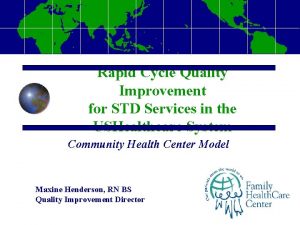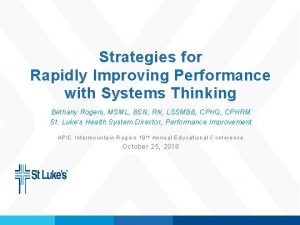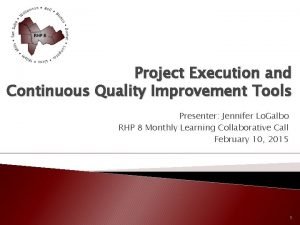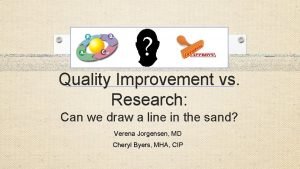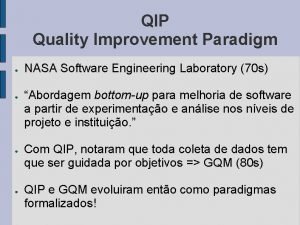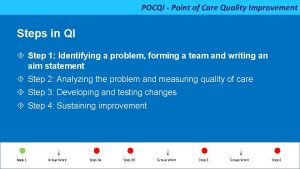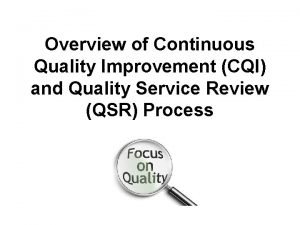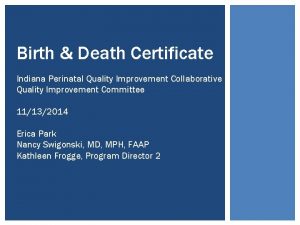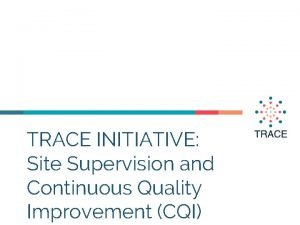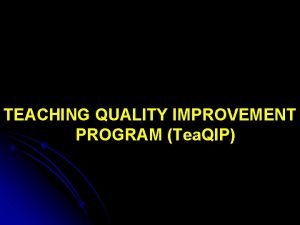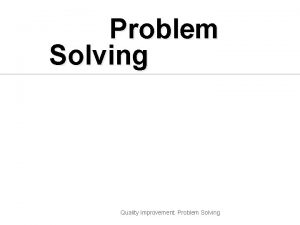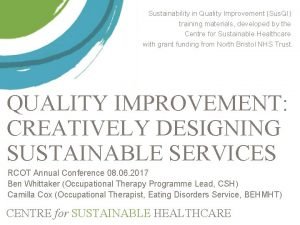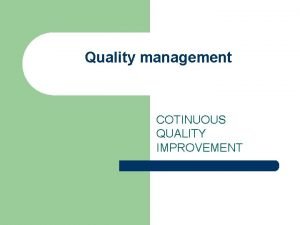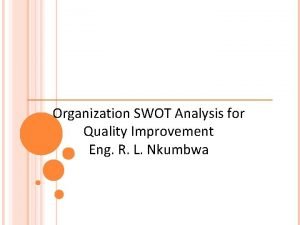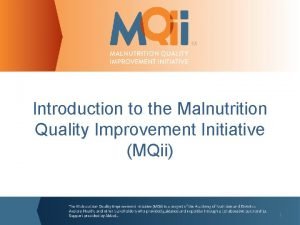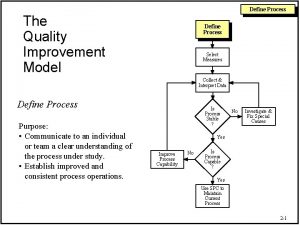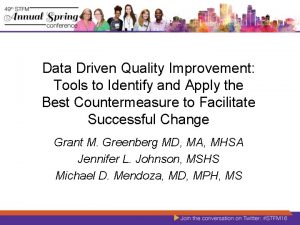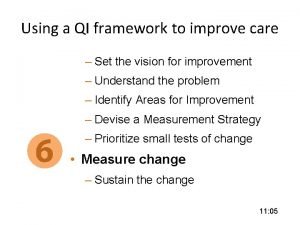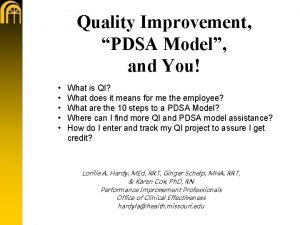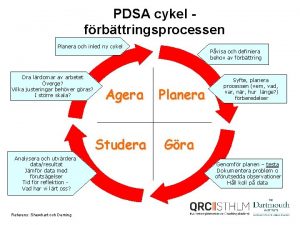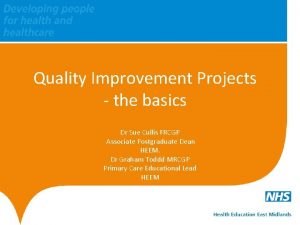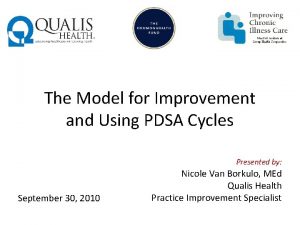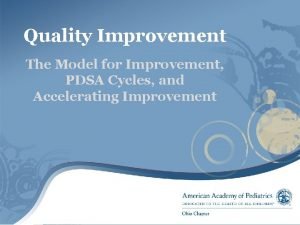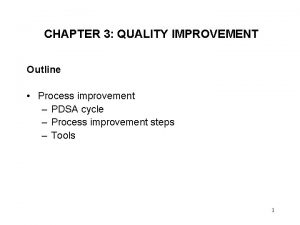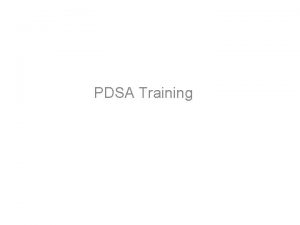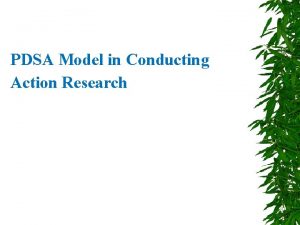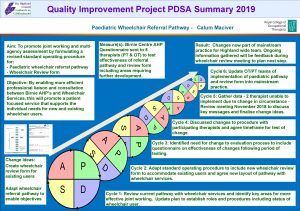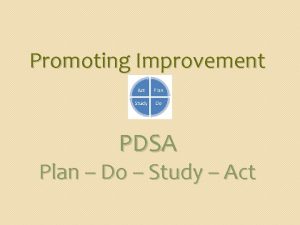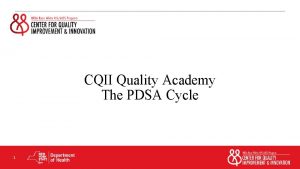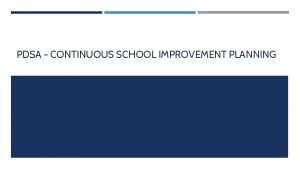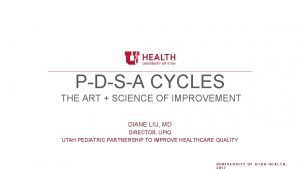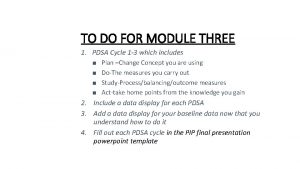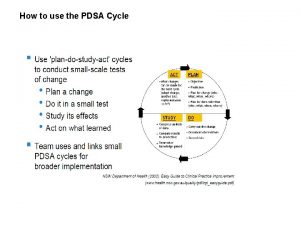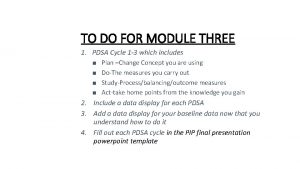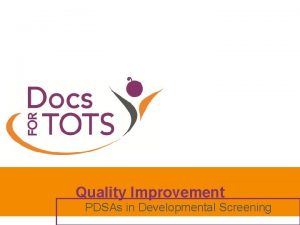Quality Improvement The PDSA Cycle Making a Plan




































- Slides: 36

Quality Improvement: The PDSA Cycle Making a Plan University of Louisville Internal Medicine Residency

Goals for Today ➢ Think about why QI is important ➢ Introduce the Model for Improvement & Plan-Do-Study-Act (PDSA) cycles ➢ Discuss your chart review results and your planned PDSA

6 Indicators of Quality Healthcare ■ ■ ■ Patient-centered Safe Timely Efficient Effective Equitable � Crossing the Quality Chasm: A New Health System for the 21 st Century, Institute of Medicine 2001

Status of US healthcare ■ ■ Preventive care varies based on access 1 Last of 11 industrialized countries overall �At ■ about twice the cost of others 2 Outcomes amenable to healthcare 3 1. Commonwealth Scorecard on U. S. Health, 2008 2. Commonwealth National Health System Scorecard, 2014 3. The Commonwealth Fund, July 2017

Percent of adults (ages 18+) who received all recommended screening and preventive care within a specific time frame given their age and sex* U. S. Average U. S. Variation 2005 * Recommended care includes seven key screening and preventive services: blood pressure, cholesterol, Pap, mammogram, fecal occult blood test or sigmoidoscopy/colonoscopy, and flu shot. Data: B. Mahato, Columbia University analysis of Medical Expenditure Panel Survey. Source: Commonwealth Fund National Scorecard on U. S. Health System Performance, 2008.


United States x 2 UK

Mortality Amenable to Health Care, 2004 and 2014 Deaths per 100, 000 population 2004 2014 Source: European Observatory on Health Systems and Policies (2017). Trends in amenable mortality for selected countries, 2004 and 2014. Data for 2014 in all countries except Canada (2011), France (2013), the Netherlands (2013), New Zealand (2012), Switzerland (2013), and the U. K. (2013). Amenable mortality causes based on Nolte and Mc. Kee (2004). Mortality and population data derived from WHO mortality files (Sept. 2016); population data for Canada and the U. S. derived from the Human Mortality Database. Age-specific rates standardized to the European Standard Population (2013). E. C. Schneider, D. O. Sarnak, D. Squires, A. Shah, and M. M. Doty, Mirror: How the U. S. Health Care System Compares Internationally at a Time of Radical Change, The Commonwealth Fund, July 2017.

How to Address These Health Disparities? ■Among nations ■Among states or health care systems ■Among patients in your own practice

Quality Improvement o o Science of improving Analysis of performance and systematic efforts to improve Making the right thing easy to do o Target changes to the unique system o Use tests to show results o Track results over time o

Quality Improvement is NOT ■ ■ Experiment with tightly controlled variables Trying harder Defining the problem without changes Changing the system without follow up

Plan-Do-Study-Act (PDSA) ➢The Coin Spins

Coin Spins: Running PDSAs ■ ■ ■ Object: spin the coin as long as you can Can use any surface, technique, and coin Spin: the time it starts spinning until it comes to a natural stop on your surface Run as many tests as possible Use each PDSA cycle to test a theory

Coin Spins: How To ■ ■ ■ Write change idea and question you are answering in plan section Make a prediction of time Spin the coin Capture observations in the “DO” section Document the time and then test again

PDSA Coin Spins and the Model for Improvement ■What problems did you encounter? ■What was the utility of: � Collecting data � Writing times down � Running lots of small cycles

Lessons from the Coin Spin Principles of a PDSA ■Be creative ■Make a prediction & theory ■Collect data-just enough ■Tests explore questions without judgment ■Document your trial runs ■Use simple data collection ■Redesign the system

Introducing the Model for Improvement ■ ■ One of many QI methods Ask 3 key questions to help define PDSA

Model for Improvement What are we trying to accomplish? How will we know that a change is an improvement? What change can we make that will result in improvement? IHI: Nolan Act Plan Study Do Aim Measurement Change

AIM: ■ What are some ways you could identify your aim-what you wanted to accomplish?

Aim: What are we trying to accomplish? How do you choose the aim of your project? ■ Errors and near misses �Root ■ cause analysis Published quality indicators �Where ■ ■ you are falling short Processes that don’t work well What drives you crazy!

Model for Improvement What are we trying to accomplish? How will we know that a change is an improvement? What change can we make that will result in improvement? IHI: Nolan Act Plan Study Do Aim Measurement Change

What will we measure to see if change is effective? Measurement: ■ ■ Need QI data to measure PDSA success Data should be ■ ■ ■ Well defined Easy to plot Easy to obtain � Integrate ■ into daily work, existing reports Just enough � Not all data, just enough to get trends

Model for Improvement What are we trying to accomplish? How will we know that a change is an improvement? What change can we make that will result in improvement? IHI: Nolan Act Plan Study Do Aim Measurement Change

What change can we make that will result in an improvement? Finding a Change ■ ■ Structure + Process=Outcomes Idea: change the SYSTEM �Not ■ ■ just try harder Make more human proof Address barriers

Another way of thinking about system changes…. Hard to do Easy to do Importance low NO Importance Maybe in the high long run… Maybe BEST

Model for Improvement What are we trying to accomplish? How will we know that a change is an improvement? What change can we make that will result in improvement? IHI: Nolan Act Plan Study Do Aim Measurement Change

PDSA Cycle ■ Plan �Identify the problems/process first �Describe how it currently happens �Describe root causes �Develop effective and workable solution

PDSA Cycle ■ Do �Anticipate/address barriers to implementation �Inform all participants in QI project �Implement the small change

PDSA Cycle ■ Study �Review and evaluate the result of the change �Requires data collection �Can occur in implementation stage

PDSA Cycle ■ Act �Reflect and act on the what was learned �Assess the results, recommend changes �Another cycle, revise project, standardize, or other? �Celebrate success!

Starting Your PDSA ■What are you trying to do? ■What will you measure? ■What change are you going to make?

Combining AIM and Measurements … Making an Aim Statement ■ An Effective Aim Statement Is: �SMART! ■ ■ ■ Specific Measurable Achievable Realistic Timely

Combining Aims and Measurements Making an AIM Statement ■ ■ Aim: Improve spirometry rates for COPD Aim statement: �Improve percent of patients with COPD that have documented spirometry from 20% to 75% by October 1. ■ Best aim statements are specific, measurable, achievable, realistic, & timely

What Change Will You Make? Find Problems to Find Changes Cause and Effect Tools -Fishbone

What Change Will You Make? Examples of Changes ■ ■ ■ Simplify Standardization Double checks Education New policies Eliminate look and sound-alikes ■ ■ ■ Checklists Reminders Architectural changes Promote effective team functioning Automation

Model for Improvement What are we trying to accomplish? How will we know that a change is an improvement? What change can we make that will result in improvement? IHI: Nolan Act Plan Study Do Aim Measurement Change
 Ana quality assurance model
Ana quality assurance model Compliance vs quality
Compliance vs quality Rapid cycle quality improvement
Rapid cycle quality improvement Model for improvement
Model for improvement Pdsa cycle in healthcare
Pdsa cycle in healthcare Continuous quality improvement plan example
Continuous quality improvement plan example Quality is free: the art of making quality certain
Quality is free: the art of making quality certain Quality improvement vs research
Quality improvement vs research Qsen definition
Qsen definition Quality improvement paradigm
Quality improvement paradigm Pocqi ppt
Pocqi ppt Define continuous quality improvement
Define continuous quality improvement Efmd quality improvement system
Efmd quality improvement system Indiana perinatal quality improvement collaborative
Indiana perinatal quality improvement collaborative Cqi action plan template
Cqi action plan template Tea quality improvement
Tea quality improvement Xerox problem solving process
Xerox problem solving process Sustainability in quality improvement
Sustainability in quality improvement Cotinuous
Cotinuous Quality improvement
Quality improvement Juran 10 steps to quality improvement
Juran 10 steps to quality improvement Swot analysis for quality
Swot analysis for quality Mqii
Mqii Quality improvement
Quality improvement Data driven quality improvement
Data driven quality improvement Pdsa worksheet
Pdsa worksheet Manfaat pdsa
Manfaat pdsa Rampa de pdsa
Rampa de pdsa Pdsa model
Pdsa model Pdsa-cykel
Pdsa-cykel Jens bejer damgaard
Jens bejer damgaard Pdsa model nhs
Pdsa model nhs Pdsa model nhs
Pdsa model nhs Pdsa sirkel
Pdsa sirkel Pdsa exemplo
Pdsa exemplo Pdsa sirkel
Pdsa sirkel Pdsa
Pdsa


